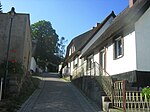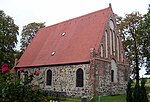Golm War Cemetery
Cemeteries in GermanyCommons category link is locally definedGerman War Graves CommissionNature reserves in Mecklenburg-Western PomeraniaProtected areas of Mecklenburg-Western Pomerania ... and 2 more
Tourist attractions in Mecklenburg-Western PomeraniaWorld War II cemeteries in Germany

The Golm War Cemetery (German: Kriegsgräberstätte Golm) is a World War II cemetery near the village of Kamminke close to the German-Polish border on the island of Usedom maintained and managed by the German War Graves Commission. The cemetery is the largest war cemetery in Mecklenburg-Vorpommern and one of the largest in Germany.
Excerpt from the Wikipedia article Golm War Cemetery (License: CC BY-SA 3.0, Authors, Images).Golm War Cemetery
Dorfstraße, Usedom-Süd
Geographical coordinates (GPS) Address Nearby Places Show on map
Geographical coordinates (GPS)
| Latitude | Longitude |
|---|---|
| N 53.883333333333 ° | E 14.2 ° |
Address
Dorfstraße
17419 Usedom-Süd
Mecklenburg-Vorpommern, Germany
Open on Google Maps











